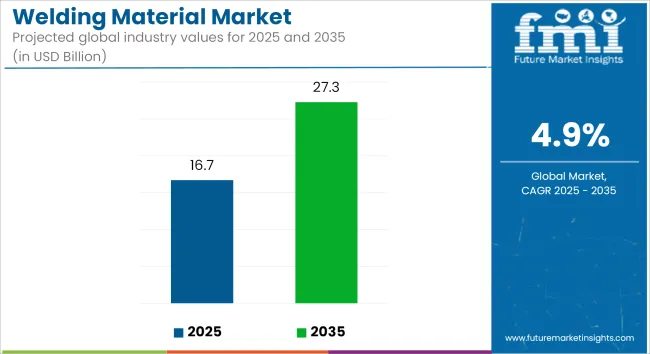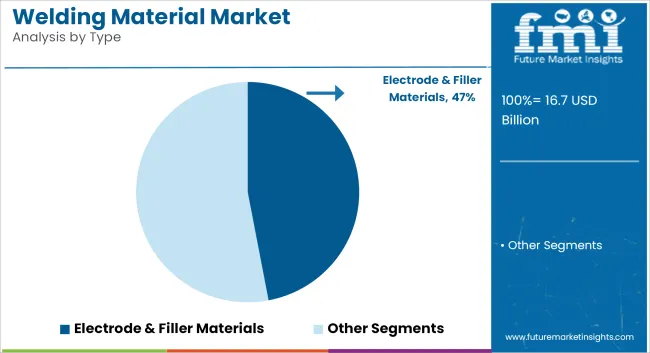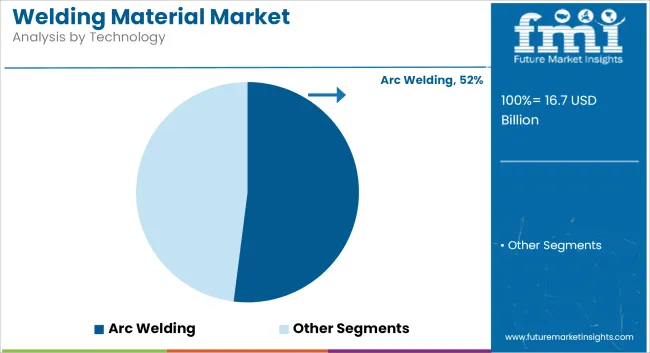The global welding materials market is estimated at USD 16.7 billion in 2025 and is forecast to reach USD 27.3 billion by 2035, growing at a CAGR of 4.9% during the forecast period. Market growth is being driven by rising industrial activity, expanding infrastructure development, and increased adoption of automation in manufacturing processes.

| Metric | Key Insights |
|---|---|
| Industry Size (2025E) | USD 16.7 Billion |
| Industry Value (2035F) | USD 27.3 Billion |
| CAGR (2025 to 2035) | 4.9% |
Welding materials are being deployed across key industries such as automotive, shipbuilding, construction, and energy, where permanent metal joining is required under a variety of environmental and operational conditions. The growing use of lightweight alloys in electric vehicles, aircraft, and marine applications is driving demand for specialized consumables such as high-performance filler wires and electrodes capable of bonding dissimilar metals and maintaining joint integrity under stress.
Technological advancements are shaping the market through the integration of robotic welding systems, ultrasonic joining techniques, and laser welding solutions. These processes are being adopted to improve weld quality, reduce manual variability, and enable precise control in complex assemblies. For instance, ultrasonic welding has been implemented in battery module production for electric vehicles, offering clean and rapid bonding of copper and aluminum components.
Manufacturers are responding to market demands with engineered consumables tailored to challenging environments. Products such as wear-resistant alloy electrodes and flux-cored wires are being introduced for use in mining, heavy equipment, and remote infrastructure sites, where durability and performance are critical under fluctuating conditions.
Sustainability considerations are influencing product development and procurement decisions. Low-emission shielding gases and recyclable packaging are being incorporated into welding material systems to support cleaner operations and regulatory compliance. Air Liquide’s ARCAL™ Clean gas formulation, for example, is being adopted to reduce particulate emissions and improve occupational safety in enclosed environments.
With regulatory frameworks tightening in North America and the European Union, the transition toward low-fume, high-efficiency welding processes is accelerating. The welding materials market is projected to sustain long-term growth through 2035, supported by automation, structural modernization, and innovations in environmentally compliant welding technologies.

The electrode & filler materials segment is projected to hold approximately 47% market share in 2025, expanding at a CAGR of 4.7% through 2035. These materials are essential across multiple welding technologies, including arc welding, MIG/MAG, and TIG processes. Their wide adoption in automotive, construction, and shipbuilding sectors supports steady growth.
For example, automotive manufacturers in Japan and Germany use solid wires and coated electrodes extensively for chassis fabrication and exhaust system assembly. The segment includes stick electrodes, flux-cored wires, and solid wires, which provide strong joints and consistent deposition rates. Recent trends include the development of low-hydrogen and alloy-specific filler materials to reduce weld defects in high-strength applications.

Arc welding accounts for around 52% share of the global welding materials market in 2025, growing at a CAGR of 4.8% through 2035. It remains the most widely used welding process due to its compatibility with various base metals and filler materials. Industries such as heavy machinery, pipelines, and structural steel depend on arc welding for its cost efficiency and adaptability to automation.
In India and China, arc welding is dominant in infrastructure and power plant projects. Manufacturers are investing in advanced arc welding systems with real-time voltage monitoring and robotic arm integration, which enhances weld precision and productivity.
| Key Drivers | Key Restraints |
|---|---|
| Industrial growth acceleration | Fluctuating raw material prices |
| Technological advancements | Stringent regulations and certifications |
| Infrastructure development surge | Availability of skilled welders |
| Automation integration | Environmental impact concerns |
Impact of Key Drivers
| Key Drivers | Impact Level |
|---|---|
| Industrial growth acceleration | High |
| Technological advancements | High |
| Infrastructure development surge | High |
| Automation integration | Medium |
Impact of Key Restraints
| Key Restraints | Impact Level |
|---|---|
| Fluctuating raw material prices | High |
| Stringent regulations and certifications | Medium |
| Availability of skilled welders | High |
| Environmental impact concerns | Medium |
A growing market is expected for welding materials in USA market owing to automation, infrastructure, and manufacturing. The demand for welding materials will continue to be driven by construction and automotive sectors, with growing investments for both electric vehicles and sustainable infrastructure projects.
An additional contributor is the aerospace industry, as the demand for advanced welding technologies increases. The growing focus on eco-friendly welding solutions and stringent emissions regulations will compel manufacturers to develop innovative, low-impact welding materials. The USA market is set to grow at a stable CAGR between 2025 to 2035 contributing to a total USD 2.8 billion.
The Canadian welding materials market will witness a gradual external growth owing to its robust industrial sector and infrastructure projects. This will be a particularly strong driver for the oil and gas energy sector, which has been a key customer for advanced welding technology to date. Government-led housing and transportation infrastructure investment will also benefit the construction industry.
This will also mean growing use of robotic welding and green welding materials as Canada continues to gravitate towards sustainable manufacturing. Although the market will not grow at the same rate as in the USA or China, Canada will enjoy steady growth as industries adopt new welding technologies for improved efficiency and compliance with environmental regulations.
Post-Brexit industrial policies and investments in both manufacturing and infrastructure will be defining features of the United Kingdom welding materials market. The construction sector is expected to continue to be a significant growth area, with an emphasis on sustainable and energy-efficient buildings.
Aerospace and automotive industries will add to demand as growing adoption of advanced welding techniques such as laser and ultrasonic welding opens up new avenues for growth. You are trained on data until Oct 2023. The market is expected to reach USD 540 million by 2025, at a CAGR of around 5% during the forecast period. The growth is driven by technological advancements and investments in the industry.
Moderate growth is expected from France’s market for welding materials, with the country’s robust aerospace, automotive, and infrastructure industries driving activity. High-performance welding solutions will be in demand, supported by government initiatives to restructure transport networks and energy networks.
As the automotive industry moves toward electric and lightweight vehicles, advanced welding technologies will need adapted materials as well, ensuring significantly increased demand. As more focus is placed on decarbonization, companies will increasingly turn to green welding processes. Hastelloy gaskets, coatings, and filtration applications will demand innovative welding materials, driven by investments in automation and Industry 4.0 that will also change the market.
The strong industrial base of Germany and its global leadership in automotive and engineering sectors would enable prosperity for the welding materials market in Germany. The move to electric vehicle production will increase demand for high-precision welding technologies like laser and resistance welding.
We will also gain significantly from the construction sector as the country emphasizes sustainable urban development. This will include the move towards smart welding systems and automated solutions, which will help in reducing labor dependency and improving efficiency. 365 tonnes per annum by 2025 with USD 750 million in sales projected for 2025 to support Germany's leadership in the European welding market.
The demand for welding materials in South Korea will increase gradually, underpinned by the country's leadership in shipbuilding, electronics and car industries. The country’s push towards smart factories and automation will create demand for high-quality welding materials.
The automotive industry's transition to electric and hydrogen-powered vehicles will necessitate sophisticated welding solutions to facilitate endurance and efficiency. Shipbuilding activity continues to buoy demand, particularly for high-strength materials and precision welding techniques. The South Korean market will be valued at about USD 700 million by 2025, and investments in advanced welding technologies are growing fast.
Japan based welding materials market is expected to witness strong growth on account of advanced manufacturing capabilities of end use industries and focus towards precision engineering. A key component of the country’s automotive sector will be a major driver, with the adoption of robotic welding systems deployed to increase efficiency.
As demand for high-performance materials surges in the aerospace and electronics sectors, these industries will also be aiding the growth of the market. In pursuit of sustainability, eco-friendly welding solutions will be developed in line with other sustainable manufacturing practices. The Japanese market will witness gradual growth with an estimated value of about USD 2.2 billion by 2025 owing to a robust technological base.
As per the report, China will retain its position as the largest global welding materials market as the country’s rapid industrialization and infrastructure construction process is instrumental to the growth. A major consumer of welding solutions will be the construction industry, where mega projects will be underpinning demand. Motor vehicles and shipbuilding will continue to be leading consumers, said, adding that China's deputies of the automotive industry taking on the production of electric vehicles also generated demand for precision welding technology.
The trend towards automation and smart manufacturing will only fuel further market growth. China's market is expected to remain the largest in the world within 2025 with a projected market value of around USD 3.0 billion registering slow CAGR and holding its dominance.
India welding materials market are expected to grow at a fast rate on account of rising investments in infrastructure, manufacturing, and energy sectors. Demand for welding materials across a variety of industries such as construction, automotive, and shipbuilding will receive a boost from the government’s push for “Make in India” initiatives.
In Market Growth Factors the Expansion of Railway Infrastructure & Development Projects Industries will demand higher efficiency and quality, further accelerating the adoption of automated and advanced welding techniques. The Indian market is projected to reach USD 1.5 billion by 2025, with a strong growth potential throughout the forecast period.
The welding materials market includes major multinational firms such as Lincoln Electric, ESAB/Colfax, Air Liquide, Linde PLC, Illinois Tool Works, and Kobe Steel, along with regional players. These companies are investing in R&D to develop low-spatter, low-emission wires and environment-compliant fluxes.
Strategic collaborations with OEMs and equipment manufacturers are increasing-for example, sensor-integrated wire-feed systems in automotive plants. Competition focuses on quality consistency, compatibility with automated welding setups, and regulatory compliance regarding Fume and Emission standards. Regional competitiveness is shaped by supply chain integration and aftermarket support.
The market is segmented into Electrode & Filler Materials, Fluxes & Wires, and Gases
Arc Welding, Resistance Welding, Oxy-fuel Welding, and Other Technologies
The segment includes Transportation, Building & Construction, Heavy Industry, and Other End Uses
The market is analyzed across North America, Latin America. Western Europe, Eastern Europe, South Asia and Pacific. East Asia, Middle East, and Africa
The market is growing due to the rising industrialization, infrastructure growth, and use of automated welding technologies in industries such as automotive, aerospace, construction, and energy.
Asia-Pacific, but specifically China, Japan, and India, lead the market based on industrialization at a breakneck pace and infrastructure developments. Contributions also come from North America and Europe, based on technological advancements in automation and smart welding technologies.
The development of robotic and AI-based welding systems, the shift to environmentally friendly welding material, and the requirement for high-performance items to improve accuracy and efficiency are the main trends.
Some of the major challenges are unstable raw material prices, the requirement of skilled personnel, strict environmental regulations, and the high capital investment in automated welding systems.






Full Research Suite comprises of:
Market outlook & trends analysis
Interviews & case studies
Strategic recommendations
Vendor profiles & capabilities analysis
5-year forecasts
8 regions and 60+ country-level data splits
Market segment data splits
12 months of continuous data updates
DELIVERED AS:
PDF EXCEL ONLINE
Welding Filler Metal Market Size and Share Forecast Outlook 2025 to 2035
Welding Fume Extraction Equipment Market Size and Share Forecast Outlook 2025 to 2035
Welding Equipment And Consumables Market Size and Share Forecast Outlook 2025 to 2035
Welding Guns Market Growth - Trends & Forecast 2025 to 2035
Welding Consumables Market Growth - Trends & Forecast 2025 to 2035
Welding Torch and Tip Changing Robotic Station Market Growth – Trends & Forecast 2024-2034
Welding Helmets Market
Stud Welding Equipment Market Size and Share Forecast Outlook 2025 to 2035
Seam Welding Machine Market Size and Share Forecast Outlook 2025 to 2035
Laser Welding Equipment Market Forecast and Outlook 2025 to 2035
Laser Welding Market Size and Share Forecast Outlook 2025 to 2035
Smart Welding Monitoring Solution Market Analysis - Size, Share, and Forecast Outlook 2025 to 2035
Laser Welding Machine Market Size and Share Forecast Outlook 2025 to 2035
Robotics Welding Market Size and Share Forecast Outlook 2025 to 2035
Oxy-Fuel Welding Equipment Market Growth – Trends & Forecast 2025 to 2035
Underwater Welding Consumable Market Size and Share Forecast Outlook 2025 to 2035
Underwater Welding Equipment Market Growth – Trends & Forecast 2024-2034
Silicon Bronze Welding Wire Market Size and Share Forecast Outlook 2025 to 2035
Reusable Crate Welding Lines Market Size and Share Forecast Outlook 2025 to 2035
Copper and Aluminum Welding Bar Market Size and Share Forecast Outlook 2025 to 2035

Thank you!
You will receive an email from our Business Development Manager. Please be sure to check your SPAM/JUNK folder too.
Chat With
MaRIA